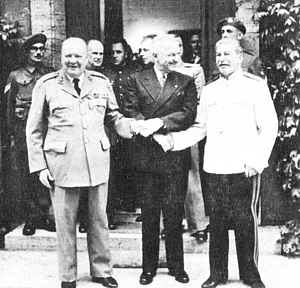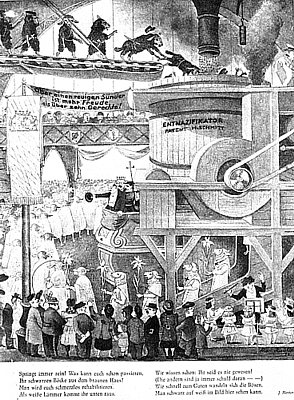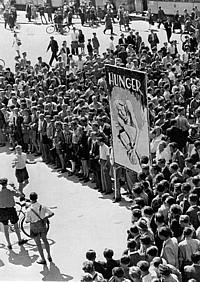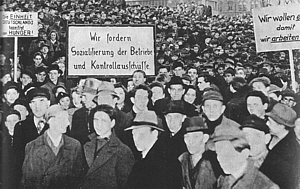UCSB Hist 133C,
L 8:
The "4 Ds" of the Potsdam Conference
(also 2 Rs and 2 turn-arounds)
by Prof. Marcuse, Jan. 23, 2004
(superceded by Jan. 2006 version)
Admin: Submit book proposals, Q3
What did the Allies do in Germany after WW2?
What were their goals?
How did they attempt to accomplish them?
- Film clip: 1994
- The Ds and Rs
Question 3
- According to Fulbrook, who was responsible for the division of Germany?
Name 3 possibilities and state BRIEFLY what made them responsible.
- Answer: textbook pages 164ff
 Causality
in History
Causality
in History
- "historical materialism:" Economics are primary
Econ, Int'l, Elites, Ideol., peOple
- Germans, for trying to take over Europe
- West German political elites, for choosing material prosperity
- US: needed a bulwark against Soviet aggression
- SU: needed to rebuild itself after German devastation
- French and British fears of a strong Germany
Film Clip
- 1994: "From Partition to Unity" (6 mins.)
- somber tone of divided country pulling itself up by bootstraps
- Allies concerned with destroying/rooting out the old
- Germans concerned with nurturing the young
- ERP (Eur. Recovery Plan) benefitted WEST only
- heading towards an upbeat end
- compares Dec. 31, 1989 and May 8, 1945
| The Potsdam Conference
- July 17 - August 2, 1945
- Main powers:
- Stalin
- Truman (Roosevelt died suddenly Apr. 12)
- Churchill (replaced by Attlee July 28)
- Ds & Rs
|
 |
| Denazification "Laundry"
The 4 Ds (5)
- Demilitarization
- The Morgenthau plan (never policy, but feared)
- Denazification ("… is like delousing")
- West/US: Nuremberg Trials; Hitler
- Soviet: remove structural causes of Nazism
- Decartellization: break up the corporate conglomerates (IG Farben,
Krupp, Siemens, ...)
- Decentralization (federation of states)
- Democratization: What and How?
|
 |
Democracy: E vs. W
- Consensus at Potsdam, but…
- Soviet: based on economic equality
- use of political parties
- example: NDPD
- Western: one person, one vote
- repression of "Antifas" at "Zero Hour"
- example: state constitutions
- Actual (Germans left to their own devices)
- example of Schwarzenberg (Thuringia), book by Stefan Heym
 |

1947: Ruhr miners demand socialization of the factories
1947: Student demonstration in Munich (left) |
2 Rs (3)
- Reeducation: the positive means of democratization
initially: "Vansittartism"--"rub noses in excrement"
- Reparations: economic scarcity makes democratization more difficult
- Resettlement / refugees
2 Turn-arounds: I
- Secretary of State Byrnes' Sept. 1946 speech. Issues:
- economics, politics, territory (see reading & full text in reader)
- Last line:
"The American people want to return the government of Germany to the German
people. The American people want to help the German people to win their
way back to an honorable place among the free and peace-loving nations
of the world."
Berlin Blockade: Turnaround II
- Causes?
- June 1948-May 1949 (860 flights/day=36/hour!)
- Berlin: "bastion of Prussian militarism" to "last outpost
of democracy"
page by H. Marcuse, prepared for web 1/24/04, updated with images 1/26/04
back to top, to UCSB Hist 133c
homepage
 Causality
in History
Causality
in History Causality
in History
Causality
in History
